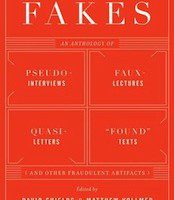Receipts, letters, diaries, grocery lists, photographs, report cards, online dating profiles – all these documents are written evidence of our existence. For most of us, they will be the only written evidence of our existence. Creating fraudulent documents as a means of evoking a fictional character is an old technique, from Jonathan Swift’s letters written in the persona of Isaac Bickerstaff, Esq. to the faux-memoir of Lolita. But the false artifact seems to be experiencing a renaissance, and David Shields and Matthew Vollmer have done us a favor with the new anthology Fakes, a solid collection that illuminates the possibilities of this form of mimicry.
To be clear, the book doesn’t deal in actual hoaxes; you won’t have to read anything else about J.T. Leroy or James Frey, praise the Lord. Nor are they typical short stories – because, really, all fiction falls under the broad umbrella of “fake”– but specifically texts that masquerade as another kind of text: the document, the email chain, the textbook. Fiction in the guise of nonfiction. Again, it’s not a new technique (early English novelists like Samuel Richardson and Daniel Defoe employed the “No, really, these are just some letters I found” method of distancing themselves from the novel’s bad reputation), but the approach has changed. These pieces are self-evidently false; they play a game of pretend with the reader, who is not asked to believe anything. One of the more well-known selections, George Saunders’s “I CAN SPEAK! tm”, for example, would not be mistaken for a real letter about talking baby-masks. Yet the joy of the piece is trying to imagine the man who purportedly wrote such a letter and the world he inhabits, in the same way that Found magazine presents us with the pleasurable combination of random chance and voyeurism inherent in the discarded objects its contributors send in. Fakes takes it one step further: what if you found a crumpled piece of paper on the ground and it turned out to actually be heart-wrenching or funny or well-written?

The anthology has an endearing order, starting with a “Disclaimer” (by David Means) and ending with a “Contributor’s Note” (Michael Martone) and an “Index” (J.G. Ballard). Humor with a dash of pathos seems to be the desired effect of most of the pieces. The inherent tension between what the text purports to be (real) and what the reader knows it to be (not real) lends itself to irony, if not outright satire. The stories are also generally on the brief side, making it a fun collection to dip into here and there.
But it’s not the lit snob’s version of a joke book to be marooned on top of a toilet tank. Pieces such as Kevin Wilson’s macabre and grief-torn “The Dead Sister Handbook: A Guide for Sensitive Boys (Laconic Method to Near Misses)”, Don Bartheleme’s abstracted “The Explanation”, and Amy Hempel’s “ Reference #388475848-5” – a parking ticket appeal that becomes a meditation on urban anonymity– bring far more than cleverness to the table.
There are more examples that could be included – the recommended reading list in the back brims with fine suggestions. Even then it’s possible to brainstorm more potential inclusions – what about A. Van Jordan’s dictionary definition poems from M-A-C-N-O-L-I-A or an excerpt from Jenny Boully’s footnotes-only The Body? What about that PowerPoint chapter from A Visit From the Good Squad?
The one area where the book is lacking is, strangely, the introduction. When I first got my hands on a copy, I was eager to read what Shields and Vollmer had to say about the current vogue for fraudulent artifacts. I liked Shields’s Reality Hunger, full of ideas that generate discussion whether you agree or passionately disagree with them, and many of which would seem to apply to the appetite for fakes. But the editors have mostly dispensed with the theorizing here, which for many readers may be a plus, opting instead for their own play on another form, that of the creative writing handbook. It’s hard to tell what the ratio of straightforwardness to tongue-in-cheekness is in this “Guide to the Manufacture and Distribution of Fraudulent Artifacts.” It reads as both genuinely encouraging and so obvious as to be a parody: “A diary will be written in first person, a contributor’s note in third;” “Your artifact will need a voice.”
But besides a few offhand comments about being enslaved by our information, there is little consideration given to the why of fakes. Why the sudden interest in reading and writing these ostensibly impersonal or anonymous texts that become unique narrative, imbued with pathos (or, sometimes, a parody of same) – like Joe Wenderoth’s comment cards at Wendy’s: “July 16, 1996 – Today I bought a salad just to look at it, smell it, rub it on my face. Again I’m feeling like a doctor, but now the feeling is clearer – I feel like an ancient doctor, with ancient ideas about what needs to be done. I asked the register-girl if it would be possible to have small holes drilled into my skull so that good strong coffee could be poured down onto my brain.”

One answer, I suspect, is that the Internet has made these sorts of pieces more publishable. A quick calculation of the permissions reveals three of the 34 selections first appeared on Timothy McSweeney’s Internet Tendency, which has given rise to a sort of house style of lists and recipes and formulas. There are also new and exciting web forms to parody, like Kari Anne Roy’s “Chaucer Tweets the South by Southwest Festival” (one of the McSweeney’s-born pieces – one which I might have traded for an older example from the suggested reading, maybe an excerpt of Twain or Borges). Or maybe it’s that in our age of anti-privacy, the double masking of the author is more appealing. Yes, Mark Halliday is the author of “One Thousand Words on Why You Should Not Talk During a Fire Drill,” but the fictional pen is in the fictional hand of the kid being punished. For once we are free to speculate about the writer’s personal relationship to the text, because the writer is part of the text, too.
I realize that my desire for the editors to conjure up an entire field of scholarship where none currently exists constitutes a pretty tall order, and Vollmer and Sheilds freely admit the incompleteness of the anthology. It’s to their credit, then, that I’m hoping for a Volume II.




